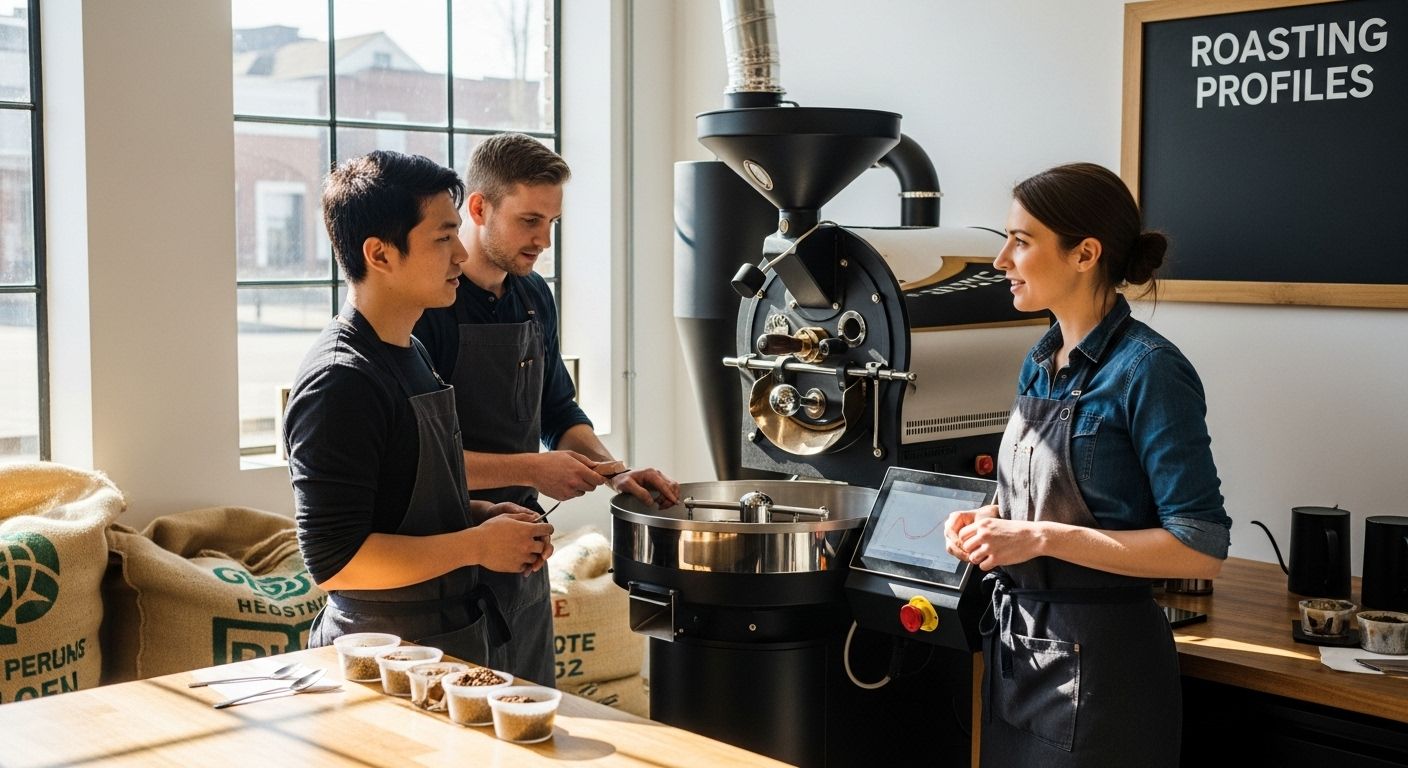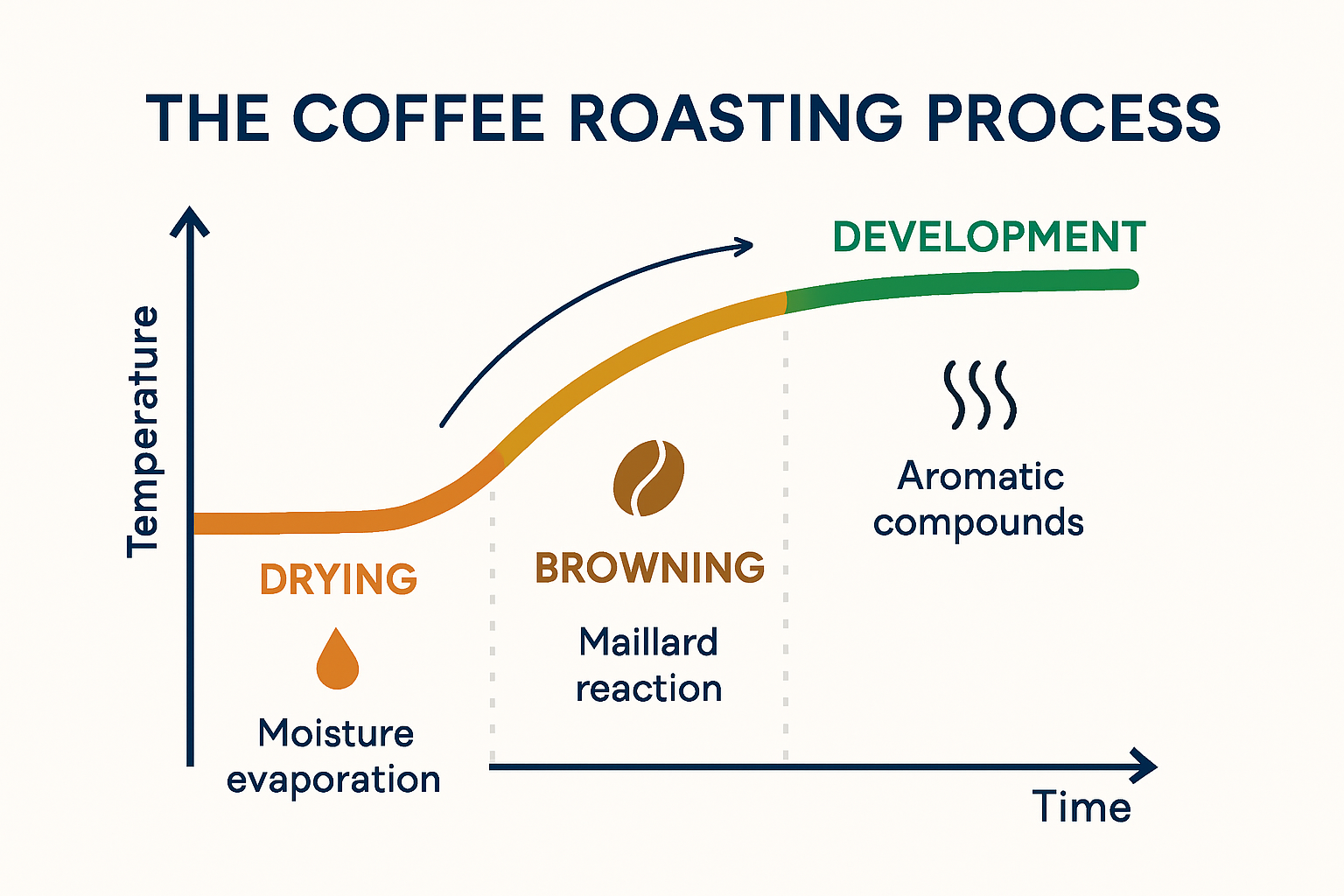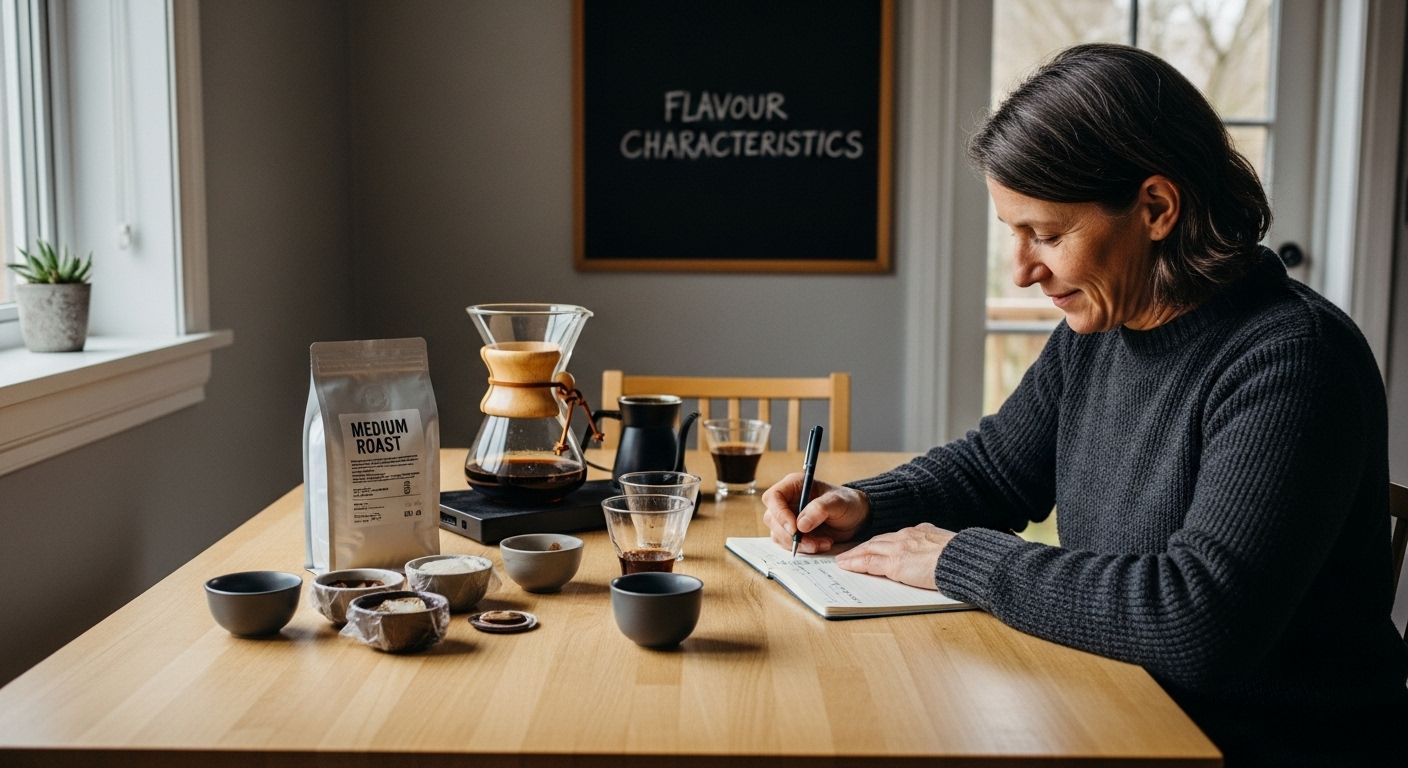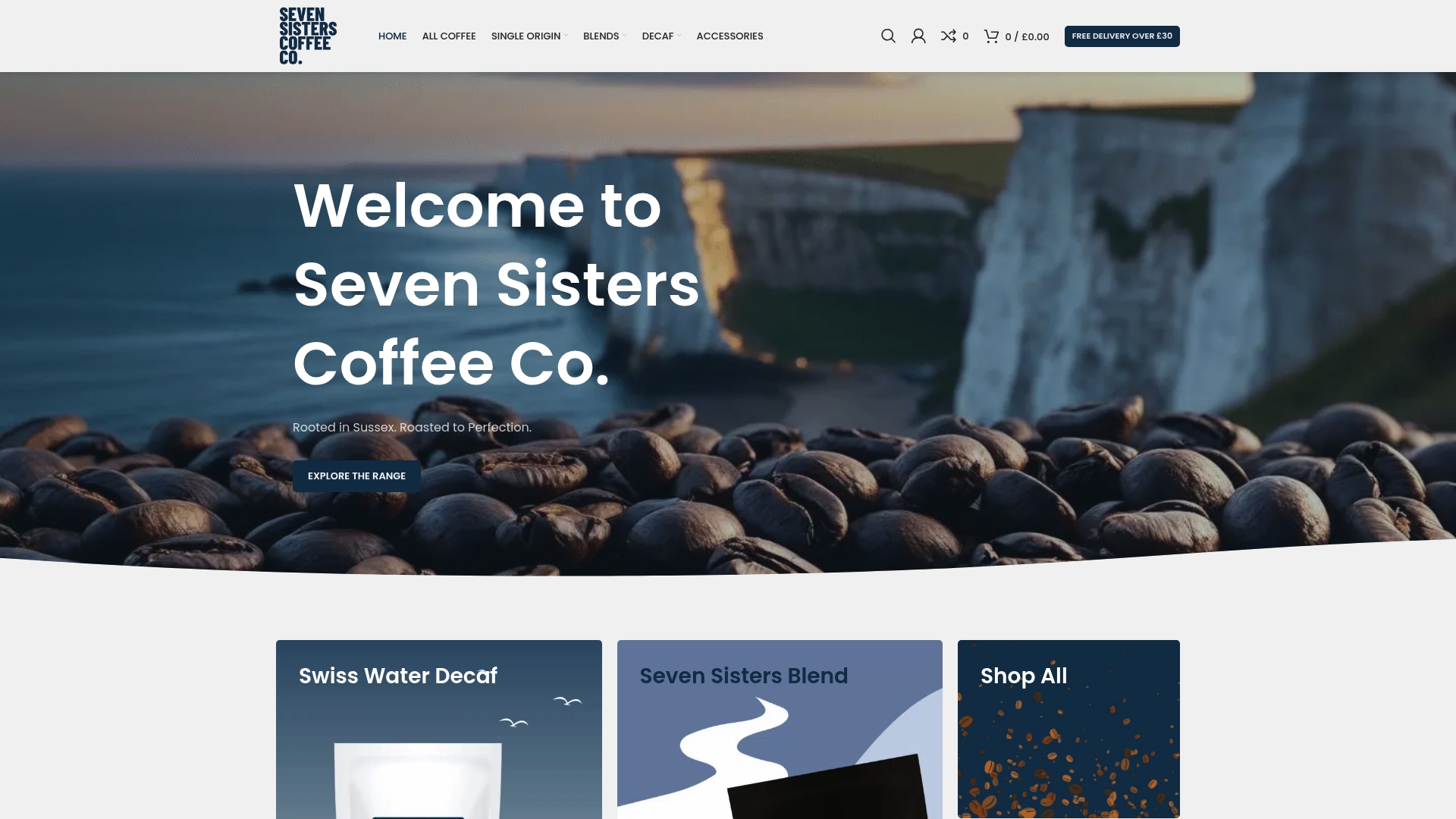Coffee Roasting Profiles Explained: Master Every Brew

Coffee roasting profiles are often seen as the secret ingredient that shapes every cup, controlling flavour right down to the tiniest detail. Yet most drinkers have no idea that a single scientific tweak in temperature or timing can change a coffee’s aroma, sweetness, and body completely. The real surprise is that cracking the perfect roast profile is not just for experts with fancy machines. Anyone can master it by learning a few clever tricks—and the difference will transform your morning mug into a personalised masterpiece.
Table of Contents
- What Are Coffee Roasting Profiles?
- How Roasting Profiles Shape Flavour
- Developing And Tweaking Your Own Profile
- Choosing The Right Profile For Your Taste
Quick Summary
| Takeaway | Explanation |
|---|---|
| Understand roasting profiles | Coffee roasting profiles dictate flavour by managing temperature and time. Each profile is a scientific approach to enhance coffee’s sensory characteristics. |
| Experiment with roasting stages | Master the drying, browning, and development stages to influence flavour intensity. Knowing these can help achieve desired taste outcomes. |
| Choose profiles based on brewing methods | Different coffees complement various brewing techniques. For instance, lighter roasts suit pour-over while darker works better for espresso. |
| Keep a tasting journal | Document each roast’s characteristics to refine personal preferences. Recording observations can enhance the understanding of flavour complexity. |
| Invest in proper equipment | Using quality roasting equipment ensures better control over temperature and results. Accurate tools can vastly improve the roasting experience. |
What Are Coffee Roasting Profiles?
Coffee roasting profiles represent the intricate roadmap of temperature and time manipulation that transforms raw green coffee beans into the aromatic, flavourful beans we brew and enjoy. At its core, a roasting profile is a precise scientific approach to developing the complex sensory characteristics of coffee through carefully controlled thermal processes.
The Science Behind Roasting Profiles
Roasting is far more than simply applying heat to coffee beans. Research from the American Chemical Society reveals that roasting profiles critically influence the chemical transformations occurring within the beans. During roasting, complex Maillard reactions and caramelization processes generate hundreds of flavour compounds, with the specific temperature curve and duration determining the final taste profile.
Professional roasters meticulously design their profiles to highlight specific characteristics of each coffee bean. These profiles typically involve three primary stages: drying, browning, and development. The drying stage removes moisture, the browning stage initiates chemical reactions that generate complex flavours, and the development stage determines the final roast level and flavour intensity.
Understanding Roast Profile Variables
Several key variables define a coffee roasting profile. Temperature progression represents the most critical factor, with roasters carefully controlling the rate of heat application. Roast duration also plays a significant role the longer beans are exposed to heat, the more sugars caramelize and oils emerge, creating deeper, more intense flavours.
Temperature curves can be categorized into different styles: fast, slow, or stepped roasting. A fast profile might rapidly increase temperature to quickly develop flavours, while a slow profile allows more gradual, nuanced flavour development. Stepped profiles introduce specific temperature plateaus to create unique flavour complexity.
For coffee enthusiasts interested in understanding more about specialty coffee production, our guide on single origin coffee selections provides additional insights into how roasting impacts bean characteristics. Each roasting profile is essentially a flavour blueprint, transforming humble green beans into a sensory experience that captures the essence of their origin and the roaster’s craft.
How Roasting Profiles Shape Flavour
Roasting profiles are the master key to unlocking the complex flavour potential within coffee beans, transforming raw green seeds into a symphony of sensory experiences. Each roasting approach acts as a unique culinary choreography, guiding chemical reactions that determine aroma, body, and taste.
Chemical Transformations and Flavour Development
Research published in 2024 reveals the intricate science behind flavour development, demonstrating how roasting profiles fundamentally alter coffee’s chemical composition. Different roasting intensities trigger specific molecular changes, generating an array of volatile and non-volatile compounds that directly influence taste characteristics.
Light roasts retain higher levels of chlorogenic acids, producing bright, acidic flavours with delicate floral and fruity notes. Medium roasts strike a balance, developing nuanced caramel and nutty undertones while maintaining the bean’s inherent characteristics. Dark roasts, conversely, introduce deeper, more robust flavours through extensive caramelization and oil emergence.
Aroma Compound Complexity
Scientific analysis from 2024 identified 25 distinct aroma-active compounds that emerge during roasting. Medium roasts particularly excel in producing pleasant sensory experiences, generating sweet notes reminiscent of toasted hazelnut and rich caramel. Dark roasts risk introducing less desirable burnt or musty characteristics if not carefully managed.
The roasting process essentially acts as a flavour architect. By manipulating temperature curves and duration, roasters can emphasize specific taste dimensions. Shorter, faster roasts preserve more of the bean’s original terroir, while extended roasting develops deeper, more intense flavour profiles.
For coffee enthusiasts eager to explore the nuanced world of specialty coffee, our comprehensive guide to bean selection offers deeper insights into understanding these remarkable flavour transformations. Each roast tells a story the story of its origin, the roaster’s skill, and the extraordinary journey from seed to cup.
Developing and Tweaking Your Own Profile
Creating a personalised coffee roasting profile is an art form that blends scientific precision with creative intuition. Home roasters and coffee enthusiasts can develop their unique flavour signatures by understanding key principles and experimenting methodically with roasting techniques.
Essential Equipment and Initial Setup
Beginning your roasting journey requires fundamental equipment. A reliable home roaster or modified popcorn machine serves as an entry point, though professional-grade drum roasters offer more consistent results. Temperature control represents the most critical factor precision is paramount. Research from the Specialty Coffee Association recommends investing in a quality thermometer and logging software to track temperature curves and bean progression.
Starter roasters should focus on small batches 100 to 250 grams initially. This approach minimises waste and allows for more controlled experimentation. Record keeping becomes crucial documenting bean origin, roast duration, temperature stages, and resulting flavour profiles helps refine future roasting attempts.
Understanding Roast Development Stages
Successful profile development requires intimate knowledge of roast progression. Professional roasters recognize three primary stages: drying, browning, and development. The drying stage removes moisture and prepares beans for chemical transformations. Browning initiates Maillard reactions, generating complex flavour precursors. The development stage determines final roast characteristics and flavour intensity.
This table outlines the key stages of coffee roasting, including their main objectives and the resulting impact on flavour. It provides an at-a-glance guide for readers developing or refining their own roasting profiles.
| Roasting Stage | Main Purpose | Flavour Impact |
|---|---|---|
| Drying | Remove moisture from beans | Prepares beans for further reactions |
| Browning | Initiate Maillard reactions | Develops complex flavour precursors |
| Development | Finalise roast characteristics | Determines flavour intensity and depth |
Experimental roasting involves subtle manipulations. Adjusting heat application rates can dramatically alter flavour outcomes. A fast initial heat application might produce brighter, more acidic profiles, while gradual temperature increases create more balanced, nuanced flavours. Temperature plateaus during roasting can introduce unique complexity, allowing specific flavour compounds to develop.
Refining Your Approach
Mastering roasting profiles demands patience and systematic approach. Begin by selecting high-quality, single origin beans that offer clear flavour characteristics. Our guide to selecting premium coffee beans provides insights into choosing beans that will best showcase your roasting skills.
Advanced roasters recommend creating reference roast profiles. Start with manufacturer suggested profiles, then gradually modify temperature curves and duration. Listen for the first and second crack sounds these auditory cues indicate critical transformation stages. Sensory evaluation tasting and comparing different profiles helps develop a nuanced understanding of how slight adjustments impact final flavour.
Remember that developing a signature roasting profile is a continuous learning process. Each roast offers an opportunity to understand bean chemistry, refine techniques, and ultimately craft a truly personalised coffee experience. Embrace experimentation, maintain meticulous records, and approach each roasting session with curiosity and precision.
Choosing the Right Profile for Your Taste
Selecting the ideal roasting profile is a deeply personal journey that connects sensory preferences with scientific precision. Understanding how different roasting approaches impact flavour allows coffee enthusiasts to craft experiences that resonate with their unique palate.
Mapping Flavour Characteristics
Research investigating coffee sensory profiles demonstrates that roasting time significantly influences key taste descriptors including characteristic odor, body, bitterness, and residual flavours. Light roasts typically preserve the bean’s original terroir, offering bright, acidic notes with complex fruity and floral undertones. These profiles appeal to those who appreciate nuanced, delicate flavour experiences.
Medium roasts represent a harmonious balance, developing rich caramel and nutty characteristics while maintaining the bean’s fundamental qualities. Scientific analysis from 2024 revealed that medium roasts generate the most pleasant aromatic compounds, including sweet notes of toasted hazelnut and delicate caramel tones. This profile suits individuals seeking a well-rounded, approachable coffee experience.
Matching Profiles to Brewing Methods
Different brewing techniques complement specific roasting profiles. Espresso enthusiasts often prefer medium to dark roasts, which provide the robust body and intense flavour necessary for milk-based drinks. Pour-over and filter methods excel with lighter roasts, allowing intricate flavour nuances to shine through. Cold brew techniques benefit from darker roasts, which extract deeper, more robust characteristics.
Consider your primary brewing method when selecting a roast profile. Espresso machines demand beans that can withstand high-pressure extraction, typically requiring more developed roasts. Conversely, manual brewing methods like Aeropress or Chemex allow for more delicate, lighter roasted beans that showcase subtle flavour complexities.
Here is a summary table comparing the main characteristics, flavour notes, and ideal brewing methods for light, medium, and dark coffee roasts. This table helps readers quickly match roast profiles to their taste preferences and brewing equipment.
| Roast Level | Key Flavour Characteristics | Predominant Flavour Notes | Ideal Brewing Methods |
|---|---|---|---|
| Light | Bright, high acidity, preserves bean’s original terroir | Floral, fruity | Pour-over, Chemex, Aeropress |
| Medium | Balanced acidity and body, well-rounded | Caramel, nutty, hazelnut | Drip, filter, espresso |
| Dark | Robust, low acidity, heavy body | Caramelised, smoky, bitter | Espresso, cold brew |
Personal Taste Exploration
Developing your preferred roasting profile requires systematic exploration. Start by sampling beans roasted to different levels side by side, noting subtle variations in aroma, body, and taste. Our guide to selecting premium coffee beans offers comprehensive insights to support your flavour discovery journey.
Advanced coffee enthusiasts recommend maintaining a tasting journal. Document each roast’s origin, roasting duration, temperature curve, and your sensory observations. This methodical approach transforms coffee exploration from casual enjoyment to a nuanced, informed appreciation. Remember that personal taste evolves experimental roasting profiles will help you continuously refine and expand your palate.
Ultimately, choosing the right roasting profile is about understanding your preferences and embracing the incredible diversity of coffee’s sensory landscape. Each roast tells a unique story of origin, craftsmanship, and personal discovery.
Frequently Asked Questions
What are coffee roasting profiles?
Coffee roasting profiles are precise methods of manipulating temperature and time to transform green coffee beans into roasted ones, highlighting specific flavour characteristics through controlled thermal processes.
How do roasting profiles affect coffee flavour?
Roasting profiles shape coffee flavour by influencing the chemical transformations during roasting. Different temperatures and times lead to varying levels of acidity, sweetness, and aroma, resulting in distinct taste experiences that reflect the coffee’s origin.
What are the key stages in the coffee roasting process?
The coffee roasting process involves three primary stages: drying, browning, and development. Each stage plays a vital role in removing moisture, generating complex flavours through chemical reactions, and determining the final characteristics and intensity of the roast.
How can I develop my own coffee roasting profile at home?
To develop a personalised coffee roasting profile, start with quality equipment, keep small batch sizes, and experiment with temperature control. Document each roast’s details, including time and temperature, and taste the results to refine your approach continuously.
Ready to Personalise Your Flavour Journey?
You have seen how even a small change in your coffee roasting profile can transform taste. If you find yourself struggling to capture those complex aromas or yearning for that signature balance between body and sweetness, you are not alone. Many coffee lovers read guides but still feel stuck with beans that do not quite deliver the magic. Imagine having the right beans and tools at your fingertips, so every brew truly reflects your unique taste.
Make today the day you explore our premium single origin coffees, blends, and decaf selections. Each product page helps you match roast profiles to your preferred brewing methods, with detailed tasting notes to guide your choices. If you are ready for perfect coffee without the guesswork, visit Seven Sisters Coffee Co. now and let your next cup be as individual as you are.




